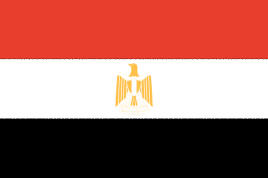 |
 |
Egypt/Italy Tour 2003: Sunday, 20 April 2003
Karnak Temples
As this was our last day on the boat, we were up early-ish in order to pack and vacate the rooms. Luggage was piled in a central place.
Karnak is approached via an avenue of Sphinxes which leads to the first pylon of Nectanebo (2)
Four pictures of the ram-headed (cryptocephalous) sphinxes
Approaching the first pylon. Image 9 shows a map of the temples and their layout, while 10 is the temple of solar barques.
Through the pylon (11) and into an open courtyard (12). Two pictures of the group (13 and 14).
Here was a pylon with its original construction ramp and from this it is believed that ramps were used to construct these large buildings.
Temple of Rameses III
We entered this temple via an open courtyard which had large statues on either side (16 and 17), into an area with closed papyrus capitals with the ceiling getting lower (18), the final, rather dark, sanctuary (19) and into a side chapel into which a spectacular beam of light enters (20).
The remaining column of the Pavilion of Taharka (21) and a statue of Rameses II (22).
Great Hypostyle Hall
This is one of the most remarkable parts of Karnak: 134 enormous columns (representing the marshes of the Delta). The following is a selection of pictures:
After the hypostyle hall we emerged into an open courtyard (30). 31 and 32 show scenes nearby.
Walking round the scarab of fertility
Temple of Thutmose III showing columns in their original colours.
The "Botanical Garden": columns with closed papyrus capitals (36) and images of birds (37) and plants (38).
Interlude at a papyrus factory
Here we were shown how papyrus is made. Firstly start from the sedge, Cyperus papyrus (the man wouldn't believe me when I said we had the same species in Zimbabwe). The inflorescence is said to look like the sun's rays and it has a triangular stem. The outer parts of the stem are used for sandals, the inner white part is cut into thin strips for papyrus.
The strips are then soaked in the water of the Nile for 6 days to remove sugars and are then spread out. The strips are arranged in order to form a sheet of paper - some in one direction, others at right angles. These sheets are pressed together for 6 days to produce the sheets of papyrus. "False papyrus" is made from banana or sugar cane.
We then went back to the boat. There was no lunch and so people generally hung around the top deck or played pool or sat and chatted. We went for a walk along the promenade. Temperatures were very pleasant - 30 degrees C was estimated and I should think that was about right. Dinner was served at 5 p.m. An "economy" meal had been negotiated but in fact it was as good as ever and given that the kids had had no lunch they really tucked in.
Later, we set off for Luxor temple.
Luxor Temple
Two pictures of the entrance to the temple:I had some difficulty in establishing after the event what the photographs were that we took. [Note to self for next time - do make notes of what each photograph is as soon as possible after taking them!].
Image 50 shows Rameses II; 51 is a picture of the hypostyle hall; 53 looks up to a door into a mosque - note how high it above the current ground level; 57 shows the open court of Amenhotep III.
We left Luxor temple and by 9 p.m. we were standing waiting on Luxor railway station platform. After the places we had seen all day, this was a grim end to the day - noise, people, diesel fumes ... and nothing to do but write my diary.
The usual attentions of hopeful vendors - bisuits and snacks, tins of coke, sweets etc. A much more relaxed atmosphere in Luxor than at Cairo station. There in Cairo we formed two laagers but tonight people are all up and down the platform and some people have gone back into Luxor to find a MacDonalds. Maybe the smaller town is safer or (more likely) we are all more relaxed about being here.

























































